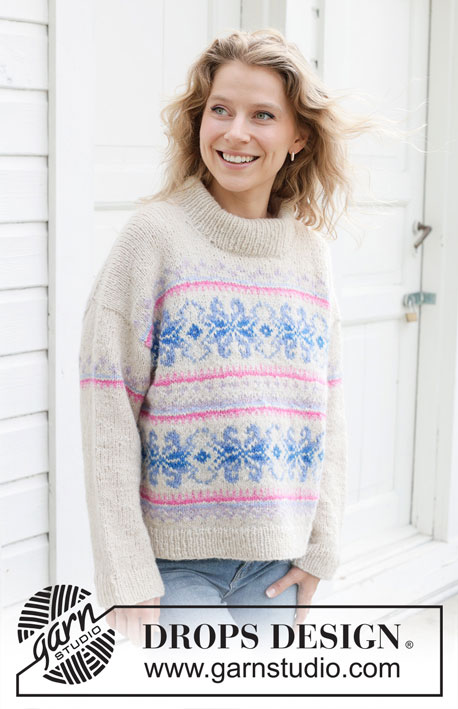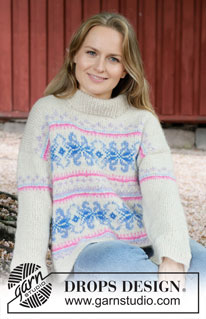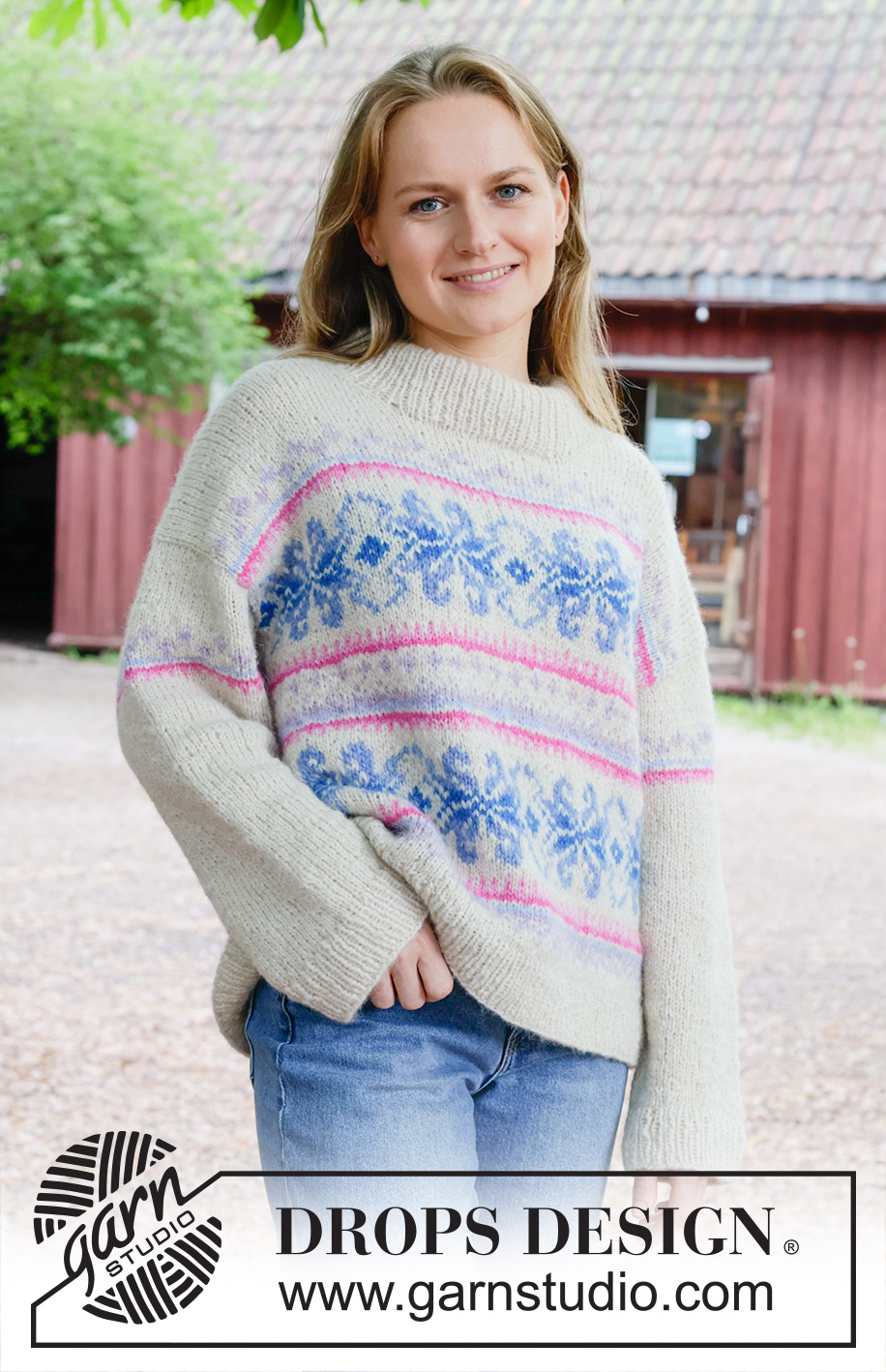Comments / Questions (5)
![]() Gabriele Bauer wrote:
Gabriele Bauer wrote:
Muss es bei RUMPFTEIL nicht heißen: weiter mit A1, A2 und A4 (gr.S) statt nur mit A2?
28.09.2024 - 14:40DROPS Design answered:
Liebe Frau Bauer, es wird A.2 gestrickt, aber siehe FORTSETZUNG DES MUSTERS:, im Falle die Arbeit in dem großen Stern geteilt wurde, dann passt das Muster unter die Ärmel nicht, so sollen Sie anpassen (siehe Beschreibung). Viel Spaß beim Stricken!
30.09.2024 - 08:00
![]() Carlota Viglizzo wrote:
Carlota Viglizzo wrote:
Weekend
10.08.2024 - 16:42
![]() Stimla wrote:
Stimla wrote:
Sweet candy
10.08.2024 - 11:37
![]() Christina Jensen wrote:
Christina Jensen wrote:
Navn: English tee Party
08.08.2024 - 19:29
![]() Carla wrote:
Carla wrote:
This is the one
08.08.2024 - 18:25
Frozen Bloom#frozenbloomsweater |
|||||||||||||||||||||||||||||||
 |
 |
||||||||||||||||||||||||||||||
Knitted over-size jumper in DROPS Air. The piece is worked top down with European/diagonal shoulders, Nordic pattern with stars and double neck. Sizes S - XXXL.
DROPS 255-5 |
|||||||||||||||||||||||||||||||
|
------------------------------------------------------- EXPLANATIONS FOR THE PATTERN: ------------------------------------------------------- INCREASE TIP-1: INCREASE 1 STITCH TOWARDS LEFT – from right side: Use the left needle to pick up the strand between 2 stitches from the previous round, pick up the strand from the front and knit the back loop. INCREASE 1 STITCH TOWARDS RIGHT – from right side: Use the left needle to pick up the strand between 2 stitches from the previous round, pick up the strand from the back and knit the front loop. INCREASE TIP-2: INCREASE 1 STITCH TOWARDS LEFT – from wrong side: Use the left needle to pick up the strand between 2 stitches from the previous round, pick up the strand from the back and purl the front loop. INCREASE 1 STITCH TOWARDS RIGHT – from wrong side: Use the left needle to pick up the strand between 2 stitches from the previous round, pick up the strand from the front and purl the back loop. PATTERN: See diagrams A.1 to A.8. The diagrams show the pattern from the right side. The pattern is worked in stocking stitch. KNITTING TIP: When working short rows, there will be a small hole after each turn. This hole can be closed by tightening the strand or using the technique German Short Rows as follows: Slip the first stitch purl-wise, take the strand over the right needle and tighten well from the back (2 loops on the needle). These loops are worked together on the next row. DECREASE TIP (sleeve): Decrease 1 stitch on each side of the marker-stitch as follows: Work until there are 2 stitches left before the marker-stitch, knit 2 together, knit the marker-stitch, slip 1 stitch knit-wise, knit 1 and pass the slipped stitch over the knitted stitch (2 stitches decreased). ------------------------------------------------------- START THE PIECE HERE: ------------------------------------------------------- JUMPER – SHORT OVERVIEW OF THE PIECE: The pattern uses both long and short needles; start with the length which fits the number of stitches and change when necessary. The piece is started back and forth, casting on stitches at the back of the neck and working the back piece top down with pattern, while increasing stitches on each side for the shoulders, which become slightly diagonal. The back piece is worked as far as the armholes. The front piece is worked in 2 sections, knitting up stitches along 1 back shoulder, working pattern and increasing for the neckline. This is repeated on the other shoulder. The right and left front sections are joined when the neckline is finished. Then work as far as the armholes. The front and back pieces are joined on the same circular needle and the body worked in the round. Stitches are knitted up around the armholes for the sleeves, which are started back and forth for the sleeve cap, then finished in the round. Stitches are knitted up around the neckline and the neck worked in the round and folded double to the inside. BACK PIECE: Cast on 29-33-33-37-37-37 stitches with short circular needle size 5 mm and colour wheat DROPS Air. ROW 1 (wrong side): Purl. ROW 2 (right side): Read INCREASE TIP-1. Knit 2, increase 1 stitch towards the left, knit until there are 2 stitches left, increase 1 stitch towards the right, knit 2. ROW 3 (wrong side): Read INCREASE TIP-2. Purl 2, increase 1 stitch towards the left, purl until there are 2 stitches left, increase 1 stitch towards the right, purl 2. Work ROWS 2 and 3 a total of 15-17-17-19-22-22 times (30-34-34-38-44-44 worked rows). After the last increase there are 89-101-101-113-125-125 stitches. The piece measures approx. 14-16-16-18-20-20 cm from the cast-on edge mid-back. Insert 1 marker outermost on one side. The piece is now measured from here! In addition, insert 1 marker in the middle stitch on the row (= mid-stitch) – allow this marker to follow your work onwards, it is used when working pattern. On the next row begin working PATTERN – read description above, as follows in the different sizes: SIZES S and XL: Work 2 stocking stitches with colour wheat, A.1, then A.2, 3-4 times, A.4 and 2 stocking stitches with colour wheat. SIZES M, L, XXL and XXXL: Work 2 stocking stitches with colour wheat, A.2, 4-4-5-5 times, A.3 and 2 stocking stitches with colour wheat. ALL SIZES: Continue the pattern back and forth – the marker-stitch should match the mid-stitch in A.2 – NOTE: On each one-coloured row, work all the stitches on the row with this colour. Remember to maintain the knitting tension. Work until the piece measures 15-15-16-17-17-18 cm from the marker, measured along the armhole, finishing after a row from the wrong side. Cut the strand, place the stitches on a stitch holder and work the left front piece along the left back shoulder as follows. LEFT FRONT PIECE: Find the left back shoulder as follows: Lay the back piece flat, right side up, with the stitch holder towards you; left side of piece = left shoulder. Start from the right side by the neck and knit up stitches as follows: Using colour wheat, knit up 1 stitch in each worked-row along the shoulder inside 1 stitch, then knit up 1 stitch in each of the next 2 rows (again inside 1 edge stitch) = 32-36-36-40-46-46 stitches. All lengths on the front piece are measured from this knitted-up row. Work stocking stitch back and forth until the piece measures 7-9-9-9-10-10 cm. Now increase for the neckline as follows: ROW 1 (right side): Remember INCREASE TIP-1. Knit 2, increase 1 stitch towards the left, knit to end of row. ROW 2 (wrong side): Purl. Work ROWS 1 and 2 a total of 4 times (8 worked rows) = 36-40-40-44-50-50 stitches. Cut the strand, place the stitches on a stitch holder and work the right front piece along the right back shoulder as follows. RIGHT FRONT PIECE: Start from the right side on the right back shoulder and knit up stitches as follows: Use colour wheat and begin 2 rows before the last increase for the diagonal shoulder on the back piece, knit up 1 stitch in each of these 2 rows, then 1 stitch in each worked-row to the neckline, inside 1 stitch, = 32-36-36-40-46-46 stitches. All lengths on the front piece are measured from this knitted-up row. Work stocking stitch back and forth until the piece measures 7-9-9-9-10-10 cm. Now increase for the neckline as follows: ROW 1 (right side): Knit until there are 2 stitches left on the row, increase 1 stitch towards the right, knit 2 – remember INCREASE TIP-1. ROW 2 (wrong side): Purl. Work ROWS 1 and 2 a total of 4 times (8 worked rows) = 36-40-40-44-50-50 stitches. Now join the 2 front pieces together as follows: FRONT PIECE: From the right side, work the 36-40-40-44-50-50 stitches from the right front piece, cast on 17-21-21-25-25-25 stitches for the neckline, work the 36-40-40-44-50-50 stitches from the left front piece = 89-101-101-113-125-125 stitches. Insert 1 marker in the middle stitch on the row (= mid-stitch) – allow this marker to follow your work onwards, it is used when working pattern. Work stocking stitch until the piece measures 12-14-14-14-16-16 cm from the knitted-up row (approx. 1-1-1-1-2-2 cm stocking stitch after the cast-on stitches on the neckline mid-front), with the next row from the right side. Now begin working pattern as follows in the different sizes: SIZES S and XL: Work 2 stocking stitches with colour wheat, A.1, A.2 3-4 times, A.4 and 2 stocking stitches with colour wheat. SIZES M, L, XXL and XXXL: Work 2 stocking stitches with colour wheat, A.2 4-4-5-5 times, A.3 and 2 stocking stitches with colour wheat. ALL SIZES: Continue this pattern back and forth – the marker-stitch should match the mid-stitch in A.2. Work until the piece measures 27-29-30-31-33-34 cm from the knitted-up row, finishing after a row from the wrong side (the same row as on the back piece). Now join the back and front pieces for the body. BODY: Continue A.2 over the 89-101-101-113-125-125 stitches on the front piece (also across the 2 stitches in colour wheat on each side), cast on 3-1-7-1-1-7 stitches (in side mid-under sleeve), continue A.2 over all 89-101-101-113-125-125 stitches on the back piece, cast on 3-1-7-1-1-7 stitches (in side mid-under sleeve) = 184-204-216-228-252-264 stitches. Cut the strand. Insert 1 marker in the middle of the 3-1-7-1-1-7 cast-on stitches under each sleeve (or in the 1 stitch, if that was all that was cast on in your size). Allow the markers to follow your work onwards – NOTE: You have 1 marker in the middle stitch on each side and 1 marker both mid-front and mid-back. Start the round in the stitch before the marker-stitch under one sleeve. Read the next section before continuing. CONTINUING THE PATTERN: The pattern A.2 is now continued in the round over all stitches until A.2 is finished in height – NOTE: If the pattern is divided in the large star, the pattern will not fit under the sleeves. Work the pattern as far as the marker stitch in each side, which is then worked with colour wheat (applies only when the star border is being worked). After the star is finished, the pattern will fit in the round, repeating A.x in width. When A.2 is finished in height, work A.5 in the round. When A.5 is finished in height, work A.6 as follows: The marker-stitch on each side is worked with colour wheat, A.6 will not fit under the sleeves; count out from the mid-stitch front and back to determine where to begin the pattern after the marker-stitch and work the pattern as far as it will go to the marker-stitch on the other side. When A.6 is finished in height, work A.7 in the round. When A.7 is finished in height, continue with stocking stitch and colour wheat until the piece measures 27-27-28-28-28-29 cm from the armhole (front piece measures approx. 54-56-58-59-61-63 cm from the knitted-up row). Change to circular needle size 3.5 mm. Work rib with colour wheat (knit 1, purl 1). AT THE SAME TIME increase 32-36-40-40-44-48 stitches evenly on the first round = 216-240-256-268-296-312 stitches. When the rib measures 5-5-5-6-6-6 cm, cast off. The front piece measures approx. 59-61-63-65-67-69 cm from the knitted-up row, the front piece is approx. 3 cm longer than the finished length, as the knitted-up row is not on top of the shoulder but positioned slightly down the back piece. The jumper measures approx. 56-58-60-62-64-66 cm. SLEEVE: Lay the piece flat and insert 1 marker at the top of the armhole (NOTE! The top of the armhole is not the same place as the knitted-up row on the front piece but approx. 6-8 cm down the front piece). Use circular needle size 3.5 mm and knit up 1 stitch in the stitch cast on mid under the sleeve / in the middle stitch cast on mid under the sleeve – AT THE SAME TIME insert 1 marker in this stitch (this marker is used when decreasing mid under sleeve). Then knit up 68-70-78-78-80-88 stitches from the right side around the armhole, making sure there are equal numbers of stitches on each side of these markers = 69-71-79-79-81-91 stitches. Change to circular needle size 5 mm. Work stocking stitch and short rows back and forth (to give the sleeve a better fit) as follows: ROW 1 (right side): Knit to 8-8-8-9-9-9 stitches past the shoulder-marker, turn – read KNITTING TIP. ROW 2 (wrong side): Purl to 8-8-8-9-9-9 stitches past the marker, turn. ROW 3 (right side): Knit to 6-6-7-8-8-9 stitches past the previous turn, turn. ROW 4 (wrong side): Purl to 6-6-7-8-8-9 stitches past the previous turn, turn. Repeat ROWS 3 and 4 until you have turned a total of 8 times (= 4 times on each side, with the last row from the wrong side). AFTER THE LAST TURN: After row 4 has been worked for the last time, turn and knit back from the right side to the beginning of the round (mid-under sleeve). Insert 1 marker in the middle stitch on the round (= mid-stitch), this marker is used when working pattern. You now work stocking stitch and pattern as well as decreasing under the sleeve. Read PATTERN and DECREASING before continuing. PATTERN: When the sleeve cap is finished, work A.8 in the round – the pattern will not fit under the sleeve, so count out from the mid-stitch on top of the sleeve to determine where to begin the pattern under the sleeve – the marker-stitch on top of the sleeve should match the mid-stitch drawn in A.8. When A.8 is finished in height, continue with stocking stitch and colour wheat. DECREASING: When the sleeve measures 1 cm from the join, decrease 2 stitches under the sleeve - read DECREASE TIP above. Decrease like this every 2nd round a total of 4-4-5-5-6-6 times, then every 3-3-2½-2½-2½-1½ cm 6-6-8-7-6-10 times = 49-51-53-55-57-59 stitches. Continue working until the sleeve measures 43-41-42-38-35-36 cm from the shoulder. Change to double pointed needles size 3.5 mm and work rib (knit 1, purl 1). AT THE SAME TIME increase 9 stitches evenly on the first round = 58-60-62-64-66-68 stitches. When the rib measures 5-5-5-6-6-6 cm, cast off. The sleeve measures approx. 48-46-47-44-41-42 cm from the top of shoulder. NECK: Use circular needle size 3.5 mm and colour wheat. Start from the right side on one shoulder-line and knit up 92-108-108-120-124-124 stitches around the neck, inside 1 stitch – the stitch number must be divisible by 2. Work rib in the round (knit 1, purl 1) for 11-11-11-13-13-13 cm. Change to circular needle size 5 mm and cast off a little loosely. Fold the neck double to the inside and fasten down with a couple of stitches at each shoulder. |
|||||||||||||||||||||||||||||||
Diagram explanations |
|||||||||||||||||||||||||||||||
|
|||||||||||||||||||||||||||||||

|
|||||||||||||||||||||||||||||||

|
|||||||||||||||||||||||||||||||

|
|||||||||||||||||||||||||||||||
Have you finished this pattern?Tag your pictures with #dropspattern #frozenbloomsweater or submit them to the #dropsfan gallery. Do you need help with this pattern?You'll find 27 tutorial videos, a Comments/Questions area and more by visiting the pattern on garnstudio.com. © 1982-2025 DROPS Design A/S. We reserve all rights. This document, including all its sub-sections, has copyrights. Read more about what you can do with our patterns at the bottom of each pattern on our site. |
|||||||||||||||||||||||||||||||

























































































Post a comment to pattern DROPS 255-5
We would love to hear what you have to say about this pattern!
If you want to leave a question, please make sure you select the correct category in the form below, to speed up the answering process. Required fields are marked *.